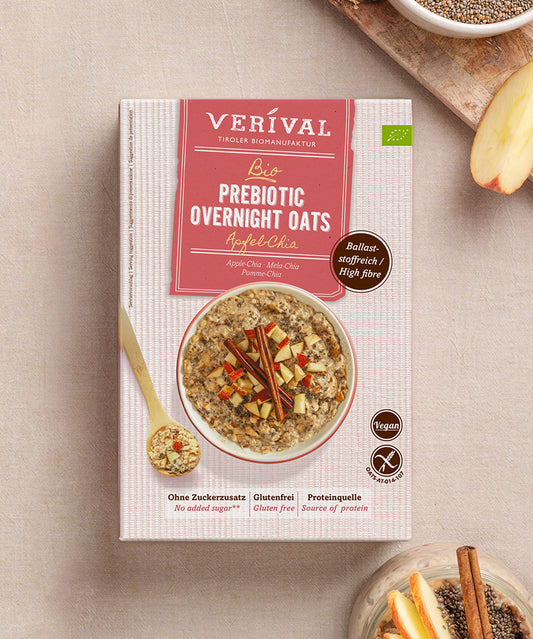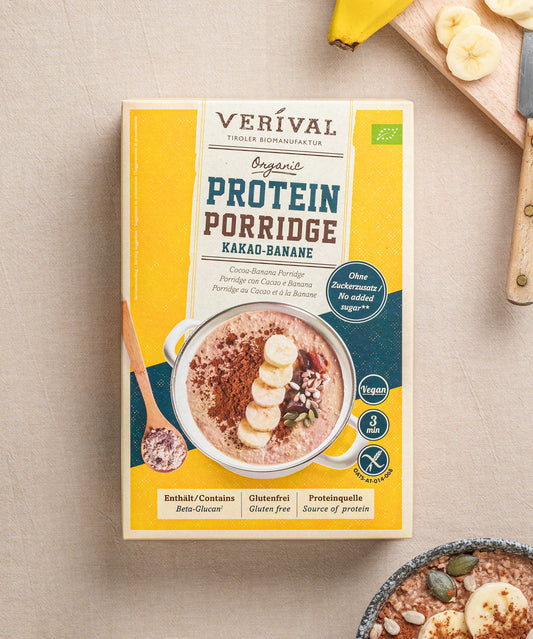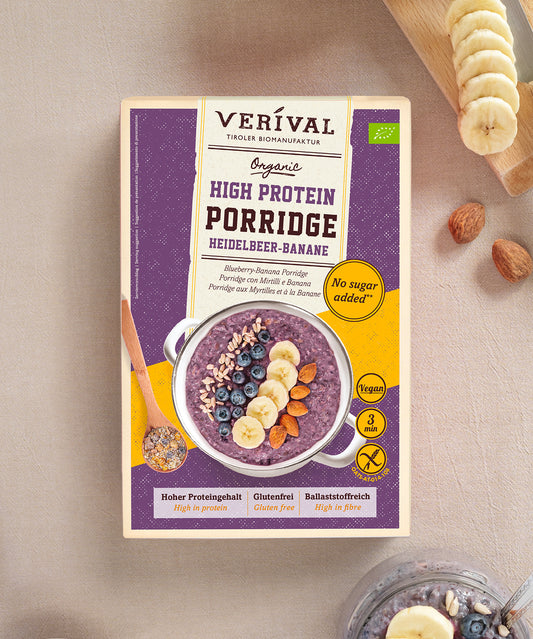Interval fasting, also known as intermittent fasting, is less of a diet and more of a lifestyle. This is because interval fasting as a way of eating is perfectly suitable for everyday use and can be followed as a long-term or even permanent concept.
With intermittent fasting, some people want to lose a few kilos, while others want to benefit from the positive effects on their health. Intermittent fasting is becoming increasingly popular, and not without reason.
This blog post will tell you exactly what intermittent fasting is, how it works and why it is so popular. We have also prepared an intermittent fasting recipe for you.
To the intermittent fasting recipe
What is intermittent fasting?
Intermittent fasting is a form of fasting in which you fast for days or hours at a time. It is often referred to as intermittent fasting. Intermittent fasting involves taking regular breaks from eating during which you do not consume any solid food. One form of intermittent fasting is the 16:8 method. This means that there are eight hours during which you eat normally and 16 hours during which you only consume unsweetened fluids.
In classic therapeutic fasting, food intake is avoided for several days. Due to the reduced calorie intake during the fasting days, the body is in a calorie deficit and is encouraged to lose weight. Unfortunately, however, it can happen that despite strict discipline, success does not materialise. In this article, you will learn what the reasons for a lack of weight loss can be, what the most common mistakes in intermittent fasting are and how these can be effectively avoided.
In principle, if you are in full health, you can try intermittent fasting (also known as alternate fasting) without further ado. If you have conditions such as low blood pressure, chronic illnesses or a metabolic disorder such as type 1 or type 2 diabetes, you should consult your doctor before starting intermittent fasting.
Avoiding food for a longer period of time is supposed to boost the metabolism and bring several health benefits. While some use this method to lose some weight without suffering the unsightly yo-yo effect, others fast for the positive health effects. Unlike traditional diets, intermittent fasting is not a temporary eating pattern. Instead, it is designed to function as a permanent change in diet. It is therefore more of a lifestyle than a diet.
Intermittent fasting is generally not suitable for adolescents, pregnant women and nursing mothers, as well as people with eating disorders or underweight individuals.
How does intermittent fasting work?
Intermittent fasting mainly involves looking at the clock. Fundamentally, this form of healthy eating is not so much about the exact choice of food as it is about the correct rhythm of food intake. Specifically, intermittent fasting involves consuming calories within a defined time frame (period of time) and avoiding food and drinks containing calories for the rest of the time.
Water, unsweetened tea and black coffee are allowed during the fasting periods. The feeling of hunger can thus be suppressed very effectively. In this way, you consciously avoid certain meals and limit your calorie intake. Since there are different variants of periodic fasting, this form of nutrition is considered to be particularly flexible. It can be adapted to individual needs and preferences and involves comparatively few restrictions. However, the basis is, of course, a balanced diet during the eating period.
Healthy eating during the fasting breaks with VERIVAL
What forms and methods of intermittent fasting are there?
There are a number of different methods of intermittent fasting, which we would like to introduce to you here. Everyone has different habits and needs, so read up on all the fasting methods before you decide. There are numerous approaches, but they all follow the same idea of helping you lose weight. The fasting period without solid food can sometimes last for days or for a certain number of hours per day. Find out which eating phase suits you. Losing weight in a healthy way only has positive effects if you feel comfortable doing it.
Interval fasting with the 16:8 method
When it comes to interval fasting using the 16:8 method, the name says it all. This involves fasting for 16 hours at a time every day and eating within an eight-hour window. It may sound like a long period of fasting, but most of the 16 hours of fasting will be spent sleeping. With this variant, you eat an early dinner and have the healthy breakfast late or not at all in order to be able to keep to the 16-hour fasting window. With intermittent fasting, you can actually lose weight while you sleep. It is very important that you get enough sleep. If not, the body produces less leptin and cravings can be the result.
Alternatively, you can also skip individual meals such as breakfast or dinner. If you are a breakfast fan, this decision is probably clear. And it is not for nothing that the English word for breakfast is ‘breakfast’ (‘break’ = to break off, interrupt and ‘fast’ = to fast) – so literally translated ‘break the fast’.
Interval fasting with the 5:2 method – The Fast Diet
With intermittent fasting, using the 5:2 diet method, you eat normally 5 days a week and fast for two days. On these two fasting days, your calorie intake is reduced to a minimum. Women eat about 500 calories and men about 600 calories on these days. On fasting days, it is best to eat low-carbohydrate and high-protein food.
It is up to you which days of the week you choose to go without your normal eating habits. The important thing is that there is at least one day in between when you eat a regular diet.
Dinner cancelling
Dinner cancelling or evening fasting is an alternative to the classic forms of intermittent fasting. This involves going without evening meals on two to three days a week and instead limiting yourself to water, tea and other calorie-free drinks.
The fasting period of at least 14 hours is intended to relieve the insulin level, help you lose weight and improve the quality of your sleep. It is also said to slow down the ageing process.
A delicious, high-energy breakfast from VERIVAL
The 2-day diet
The 2-day diet involves limiting yourself to a maximum of 650 calories on two consecutive days in a week. The diet should be low in carbohydrates and high in protein. The diet should include plenty of fish, chicken, eggs, dairy products, tofu, vegetables and fruit.
The rest of the week can be a normal mixed diet without any restrictions. In addition to the low energy intake on fasting days, a maximum of 40 per cent of the energy intake should come from carbohydrates.
Alternate-day fasting
Alternate-day fasting (ADF) is also known as ‘eat stop eat’, ‘updaydownday’ or ‘alternating fasting’. The basis of this form of nutrition is to consume only about a quarter of the usual amount of energy on the fasting days. Fasting days and non-fasting days alternate.
Short-term fasting – why is it so effective?
Intermittent fasting differs significantly from longer fasting cures or crash diets:
Since the metabolism is not slowed down, no muscle mass is lost. This way, the dreaded yo-yo effect can be avoided. In addition, fasting leads to cell cleansing and regeneration, which in biomedicine is known as autophagy.
These biochemical changes in the body can have a healing effect, which is why this form of nutrition is also referred to as therapeutic fasting. Sugar and fat metabolism are improved and the risk of chronic inflammation is reduced.
Losing weight with intermittent fasting
To lose weight with intermittent fasting, it is not necessary to count calories as with other diets. Meals should consist mainly of healthy, nutritious foods.
By refraining from eating during fasting phases, fewer calories are consumed overall than under normal circumstances. This often results in a reduced calorie intake and weight loss. A calorie calculator can help you to know exactly how many calories you need. Depending on your activity, age, gender and weight, the daily energy requirement varies.
Click here for the VERIVAL calorie calculator.
During the eating period, fat burning is promoted in the body. About 12 hours after your last meal, your body begins to access your fat reserves for energy (to a certain extent out of necessity). For this reason, intermittent fasting is also very popular with strength athletes.
Tip: Do you want to use intermittent fasting to do something good for your body? Then try not to go overboard during ‘eating time’. If you manage to keep your blood sugar level constant, you have a good chance of losing weight successfully in the long term. In addition, there are five good reasons why you should eat a warm breakfast.
How much weight can you lose with 16:8 intermittent fasting?
Most people who choose intermittent fasting either want to improve their health or lose weight. It is not possible to say how much weight you can lose with 16:8 intermittent fasting. It depends on several factors, such as your starting weight, the respective calorie deficit, the foods you eat and whether exercise plays a role in your daily fasting routine. In addition, common mistakes are made during intermittent fasting that significantly affect the success of weight loss, such as not getting enough sleep.
Does fasting slow down your metabolism?
There are no studies that would prove that fasting slows down the metabolism; quite the opposite. With intermittent fasting, you go for longer periods without food. This has the effect of boosting the metabolism, especially when combined with sufficient exercise. The healthy eating that is recommended during the eating phases also has a positive effect on cell metabolism and hormone balance.
Who is not suited to intermittent fasting?
Pregnant women, breastfeeding women, children and people with eating disorders should definitely not try intermittent fasting. But people suffering from psychosis, chronic illnesses (such as type 2 diabetes), depression or heart disease should not fast either.
As a general rule, if you are in perfect health, you can try intermittent fasting without hesitation. In all other cases, you should definitely consult your doctor in advance.
Risks of intermittent fasting
Intermittent fasting is generally not dangerous because your body is regularly supplied with food. However, especially at the beginning, symptoms such as tiredness and exhaustion can occur. If these do not go away over time or become a severe burden, you should stop fasting and consult a doctor.
In addition, the body releases more stress hormones during the fasting phase. So if you are already stressed, interval fasting puts additional strain on you and your body. If in doubt, you should always consult a doctor about changing your diet.
Breakfast for more power - try the VERIVAL Sport Range now
Mistakes in interval fasting
Mistakes are often made when intermittent fasting, which have a negative effect on the success of the diet. Anyone who sees intermittent fasting as a crash diet with quick results has already lost out. Instead, intermittent fasting is a form of nutrition that helps you lose weight in the long term without the yo-yo effect and improves your health.
Impatience with losing weight, setting the bar too high and not enough exercise are probably the most common reasons why intermittent fasting fails. But there are other mistakes too. Read on to find out the 10 most common mistakes made when intermittent fasting.
What can you drink when intermittent fasting?
When intermittent fasting, you can basically drink water, black coffee and tea (both unsweetened). It is a good idea to enrich your water with fruit or organic lemon slices and cucumbers. This is particularly refreshing in summer. Vegetable broth can also be drunk in moderation. During the eating phase, you can also drink your usual coffee.
Since alcohol contains a lot of calories, you should only drink it in moderation and only during the eating phase, and you should opt for a glass of wine or beer instead of sugary alcopops or cocktails. A good alternative is, for example, a refreshing soda water with a dash of lemon or fresh fruit.
Intermittent fasting: is coffee with milk allowed?
In principle, you should drink black coffee during the fasting phase of intermittent fasting and not add any milk or cream. Milk contains calories and lactose, which is why it is not actually allowed during the fasting phase. However, you can enjoy a coffee with milk during the eating phase.
The scientific study situation on intermittent fasting
There are a number of scientific studies that report positive effects of intermittent fasting. Scientific animal studies have shown that regular fasting can reduce the risk of chronic diseases.
These include:
- Type 2 diabetes mellitus
- cardiovascular diseases
- neurological diseases such as strokes, Parkinson's disease or multiple sclerosis
- cancer
In addition, it has been shown that intermittent fasting has a positive effect on brain function. According to the German Nutrition Society, there are also life-prolonging effects [1] of intermittent fasting, which have been proven in animal experiments.
However, clinical studies on humans that prove the effect of intermittent fasting [2] on the organism are few and the results are inconclusive. There is evidence that intermittent fasting can have a positive effect on health and weight loss, or at least corresponds to a continuous calorie deficit.
Intermittent fasting has achieved particularly good results in terms of loss of fat-free mass. In a study comparing intermittent fasting with an energy-restricted diet, it was found that less fat-free mass was lost with intermittent fasting. In addition, it was found that intermittent fasting achieved improved insulin sensitivity and reduced more body fat.
One study also looked at the effects of intermittent fasting on BMI. It tested the extent to which intermittent fasting affects BMI differently than conventional forms of dieting with a calorie deficit. Although no significant differences were found here, there was clearly a positive effect on weight loss and health in general.
It is also assumed that it has no negative side effects. However, it remains to be seen whether the method proves to be more effective than traditional diets.
That's why intermittent fasting is so healthy
Those who can integrate intermittent fasting well into their daily routine can certainly benefit from its positive effects. For example, it is said that our bodies activate their self-healing processes during fasting, which has a cleansing effect on the organism.
Many people also report more energy through food abstinence. Since the body does not have to expend resources on digestion during the fasting period, we feel fitter and more energetic. Last but not least, intermittent fasting is even said to prevent various diseases. These include, for example, cardiovascular diseases, diabetes or even skin diseases such as acne or atopic eczema. There are now also numerous intermittent fasting apps – we have summarised the best ones for you.
With our porridge and muesli you can optimally supply your body with the necessary nutrients and avoid periods of hunger outside of the fasting period. Whether it's for a late breakfast, for lunch or as a snack in between, we at VERIVAL have the right product for every moment and every taste. Make intermittent fasting easier with VERIVAL.
Is fasting more than just a diet?
Fasting cures are usually not comparable with diets. In particular, interval fasting should not be seen as a diet and certainly not as a crash diet that makes the pounds tumble in no time. This is an all too common misconception and the reason why this method of fasting does not lead to the desired success for many people!
Instead, intermittent fasting is more of a dietary change and a long-term way to live healthier. Intermittent fasting has many health benefits, such as more energy, activation of self-healing processes, and better sleep.
Intermittent fasting: daily schedule and times for a 7-day rhythm
The beauty of intermittent fasting is that you can organise your daily schedule and the times when you want to fast or eat yourself. Intermittent fasting is therefore very individual. Depending on the method you choose, you can organise your daily schedule and times yourself. Here are a few examples of a daily schedule and timetable for each intermittent fasting method:
Daily schedule for the 16:8 method
If, for example, you choose the 12:00-20:00 eating and 20:00-12:00 fasting option, eating is allowed from 12:00! Now you can enjoy a full lunch. In the afternoon, you can have a healthy snack or a cup of coffee with milk. Dinner is allowed until 8:00 p.m. Of course, we also have a more detailed daily schedule for the 16:8 method for you!
Schedule for the 5:2 method
With the 5:2 method, there are no time restrictions, except that you eat normally for 5 days and fast for 2 days. It's best to start your day with a healthy breakfast and end it with a delicious, light dinner. We have put together a sample day of intermittent fasting according to the 5:2 method, including healthy recipes.
Daily schedule for alternating fasting
With intermittent fasting, there are no exact times when you should eat, nor do you have to keep to a time window. However, it's best to enjoy a balanced breakfast every day that will keep you full and energised for a long time!
Time and daily schedule for dinner cancelling
With dinner cancelling, you should fast for at least 14 hours. To do this, skip dinner 2-3 times a week. To make it through without getting hungry, it's best to eat a hearty breakfast, a balanced lunch and a high-fibre snack in the afternoon.
Daily schedule for a 2-day diet
During the two consecutive fasting days, you may only consume around 650 calories. Since this is very little, you should eat many small meals throughout the day that are high in fibre and protein and low or free of fat and sugar. You can find suitable recipes for the 2-day diet here.
Interval fasting recipe – porridge for a healthy and satisfying meal
This interval fasting recipe tastes delicious and provides you with lasting energy. The oats in the porridge provide you with complex carbohydrates and help keep your blood sugar level constant. In addition, oats contain important proteins, minerals and vitamins that should not be missing from your healthy diet.
Try the recipe and feel the beneficial effect!
Intermittent fasting – chocolate banana porridge for a satisfying meal
This intermittent fasting recipe is ideal as breakfast, lunch or even dinner during your fasting break. It will keep you full for a long time and make it easier to get through the fasting period.
15 mins
total time 15 mins
servings: 1
Ingredients
- microwave or hot water
- bowl
Ingredients
- 50 g ORGANIC Sport Porridge – Chocolate Banana
- 150 ml water, milk or a plant-based drink of your choice
- 1 pinch of salt
- 1 banana
- 1 tsp cocoa powder (sugar-free)
Preparation
- Put the VERIVAL Sport Porridge in the bowl and mix it with the hot water or the liquid of your choice.
- Cut the banana into small slices and add it to the porridge in the bowl.
- If you don't use hot water, you can use the microwave to heat the porridge. Don't have a microwave? Then simply prepare the porridge in a pot.
- When the porridge is hot, you can now stir in the cocoa powder.
- Let your porridge steep for 1-2 minutes and then decorate as you please. Now it's time to enjoy!
Discover the delicious organic breakfast from VERIVAL
FAQ – all questions and answers about intermittent fasting
What is the best way to start intermittent fasting?
Before you start intermittent fasting, it makes sense to first find out about the different methods (16:8, 5:2, alternating fasting, etc.). Since fasting and success with it is always very individual and only works if you feel comfortable with it, it is important to find the right approach for you. It's best to read up on the different methods and decide which one is best for you based on your daily routine and your own needs and preferences. Then it's time to move step by step towards a new diet. Small changes are definitely recommended for those new to fasting, otherwise frustration can quickly set in. And remember: patience is a virtue!
What are the times involved in intermittent fasting?
In principle, there are no fixed times for intermittent fasting, but rather different periods or intervals that must be adhered to. You can decide when you eat and adjust it to your daily routine. If you follow the 16:8 method, for example, you eat breakfast at 8:00 a.m. and then you can only eat until 4:00 p.m., after which you fast until the next day at 8:00 a.m. Of course, you can also skip breakfast and plan a later dinner instead.
With the 5:2 method, you can eat normally for five days and fast for two days. With alternate-day fasting, you fast every other day.
How many calories can you eat during intermittent fasting?
How many calories you can eat during intermittent fasting depends on the method you choose. With the 16:8 method, where you fast for 16 hours and eat for 8 hours, there is no calorie limit. However, you should still pay attention to what you eat during the ‘eating hours’ and not just eat fast food or foods that are high in sugar. With the 5:2 diet, you eat five days a week and fast heavily for two days. Women should only consume 500-800 calories and men 600-850 calories.
How quickly can I lose weight with 16:8?
The human body needs at least 2-3 weeks to get used to intermittent fasting and the change in diet. After that, you should start to see the first visual changes. However, how quickly you lose weight with 16:8 is always very individual and depends on several factors. On the one hand, metabolism plays a crucial role. Although interval fasting significantly boosts metabolism, not everyone is at the same starting point. On the other hand, it depends on how much excess weight someone has. After all, the first kilos fall faster in severely overweight people.
How effective is 16-hour fasting?
16-hour fasting is a form of intermittent fasting and differs significantly from crash diets. That's why it takes a little longer to see visible results with this form of weight loss. Nevertheless, 16-hour fasting is very effective because it boosts the metabolism and there is no risk of the yo-yo effect. In addition, cell cleansing and regeneration take place and the fat and sugar metabolism are improved. The quality of sleep also improves because the body is not busy with digestion at night.
How often and how long should intermittent fasting be done?
Intermittent fasting is a change in diet and thus a form of nutrition that can be used long term. However, it can also be considered as therapeutic fasting and then only followed for a few weeks. In principle, the individual incentives for intermittent fasting determine the duration and frequency. It is only important that the body receives all the necessary nutrients.
What can you eat with 16:8?
In principle, you can eat anything when fasting intermittently and using the 16:8 method. However, you should be careful not to consume too many calories. You should eat wholemeal products, vegetables, fruit, nuts, healthy power foods, and foods rich in protein and fibre. You should also avoid foods such as fast food, sugar, white flour products, meat and sausage products, ready meals, soft drinks, sweets and other unhealthy snacks, otherwise your metabolism will be inhibited and weight loss reduced.
Interval fasting: side effects?
Intermittent fasting is a change in diet and is certainly an unusual form of nutrition for the body at the beginning. This means that sleep disorders, headaches, circulatory complaints, feelings of weakness or tiredness may occur at the beginning. However, this should change after the first few days and improve. Ultimately, intermittent fasting gives you more energy and boosts your metabolism.
How does intermittent fasting work?
Depending on which method of intermittent fasting you choose, you can either eat for eight hours and then fast for 16 (16:8 method), eat for five days and then fast for two (5:2 method), or fast every other day (alternating method). With the 16:8 method, for example, you have breakfast at 8:00 (or when it suits you) and then you can eat until 16:00. After 16:00, the fasting phase begins and you cannot eat again until the next day at 8:00. You are always allowed to drink. During the fasting phase, however, you should only drink water, unsweetened tea and black coffee.
Intermittent fasting and belly fat
Most people who choose intermittent fasting want to lose weight and also lose belly fat. While intermittent fasting generally has a positive effect on the loss of belly fat, people often make drastic mistakes that have a negative impact on their ability to achieve their goal. Typical mistakes include: not exercising enough or at all, eating unhealthy foods during the eating phases, not drinking enough fluids, and getting too much stress and sleep.
Intermittent fasting – what is allowed?
In principle, anything goes with intermittent fasting, except for eating food or drinking drinks containing calories during the fasting periods. However, success is greater if you avoid foods such as white flour products, sugar, ready meals, soft drinks, fatty meats and sausages, as well as fast food and sweets. Instead, it's better to eat complex carbohydrates, wholegrain products and foods containing protein. When it comes to drinks, it is best to choose sugar-free drinks such as water, tea and black coffee.
- Deutsche Gesellschaft für Ernährung e.V.: Intervallfasten. URL https://www.dge.de/. – accessed 2021-06-15. – Deutsche Gesellschaft für Ernährung e.V.
- Mattson, Mark P. ; Longo, Valter D. ; Harvie, Michelle : Impact of intermittent fasting on health and disease processes. In: Ageing Research Reviews , Elsevier BV (2017), pp. 46–58
























